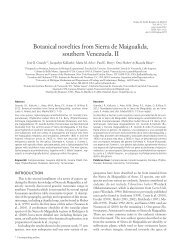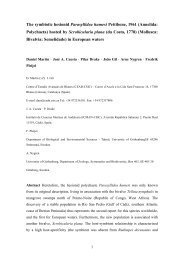real academia de la historia antiquaria hispanica 23 - Digital.CSIC ...
real academia de la historia antiquaria hispanica 23 - Digital.CSIC ...
real academia de la historia antiquaria hispanica 23 - Digital.CSIC ...
Create successful ePaper yourself
Turn your PDF publications into a flip-book with our unique Google optimized e-Paper software.
DE POMPEYA AL NUEVO MUNDO: LA CORONA ESPAÑOLA Y LA ARQUEOLOGÍA EN EL SIGLO XVIII<br />
CACCIOTI, B. Y MORA, G., 1995, «La moneda ibérica en<br />
<strong>la</strong>s colecciones y tratados <strong>de</strong> numismática españoles<br />
<strong>de</strong> los siglos XVI a XIX», I EPNA, 351-359.<br />
CACCIOTTI, B., Y MORA, G., 1996: «Coleccionismo <strong>de</strong><br />
antigüeda<strong>de</strong>s y recepción <strong>de</strong>l c<strong>la</strong>sicismo. Re<strong>la</strong>ciones<br />
entre Italia y España en el siglo XVIII», Hispania,<br />
56, 63-75.<br />
CALATAYUD ARINERO, Mª Á., 1987, Catálogo <strong>de</strong> documentos<br />
<strong>de</strong>l Real Gabinete <strong>de</strong> Historia Natural (1752-<br />
1786). Fondos <strong>de</strong>l archivo <strong>de</strong>l Museo Nacional <strong>de</strong><br />
Ciencias Naturales, Madrid.<br />
CALATAYUD ARINERO, Mª Á., 1988, Pedro Franco Dávi<strong>la</strong>,<br />
primer director <strong>de</strong>l Gabinete <strong>de</strong> Historia Natural<br />
fundado por Carlos III, Madrid.<br />
CALATRAVA ESCOBAR, J., 1994, «Arqueólogos y<br />
anticuarismo en el siglo XVIII. A propósito <strong>de</strong>l<br />
<strong>de</strong>scubrimiento <strong>de</strong> Hercu<strong>la</strong>no», en M. Peñalver (ed.),<br />
De <strong>la</strong> ilustración al romanticismo, IV. Carlos III, dos<br />
siglos <strong>de</strong>spués. Cádiz-1988, vol. 2, Cádiz, 279-286.<br />
CALATRAVA ESCOBAR, J., 1999, Arquitectura y cultura en<br />
el siglo <strong>de</strong> <strong>la</strong>s luces, Granada.<br />
CALLE MARÍN, S., 1997, «Tanucci y su vincu<strong>la</strong>ción con<br />
el nacimiento <strong>de</strong> <strong>la</strong> Arqueología», en La cristalización<br />
<strong>de</strong>l pasado: génesis y <strong>de</strong>sarrollo <strong>de</strong>l marco<br />
institucional <strong>de</strong> <strong>la</strong> arqueología en España, Má<strong>la</strong>ga,<br />
63-69.<br />
CAMPABODAL I BERTÁN M., 2006, La Reial Académia <strong>de</strong><br />
Bones Lletres <strong>de</strong> Barcelona en el segle XVIII. L’ interès<br />
per <strong>la</strong> història, <strong>la</strong> llengua i <strong>la</strong> literatura cata<strong>la</strong>nes,<br />
Barcelona.<br />
CAMPOS Y FERNÁNDEZ DE SEVILLA, F. J., 1996, Enrique<br />
Flórez. La pasión por el estudio, Madrid.<br />
CAMPOS Y FERNÁNDEZ DE SEVILLA, F. J., 2000, «El P. Enrique<br />
Flórez y <strong>la</strong> España Sagrada», en: E. Flórez,<br />
España Sagrada tomo I. C<strong>la</strong>ve Geográfica, R.<br />
Lezcano (ed.)<br />
CAMPOS Y FERNÁNDEZ DE SEVILLA, F. J., 2001, «Iconografía<br />
<strong>de</strong>l P. Flórez y su obra como dibujante (1702-<br />
1773)», en Iconografía agustiniana, XI Congreso<br />
Internacional <strong>de</strong> Historia <strong>de</strong> <strong>la</strong> Or<strong>de</strong>n <strong>de</strong> San<br />
Agustín Roma, 259-284.<br />
CAMPOS Y FERNÁNDEZ DE SEVILLA, F. J., 2002, La correspon<strong>de</strong>ncia<br />
<strong>de</strong>l P. Enrique Flórez con los ilustrados<br />
españoles, Real Monasterio San Lorenzo <strong>de</strong>l Escorial.<br />
CAMPOS Y FERNÁNDEZ DE SEVILLA, F. J., 2003, «Las Re<strong>la</strong>ciones<br />
Topográficas <strong>de</strong> Felipe II: índices, fuentes y<br />
bibliografía», Anuario Jurídico y Económico<br />
Escurialense, XXXVI, 439-574.<br />
CAMPOS Y FERNÁNDEZ DE SEVILLA, F. J., 2010a, «El P.<br />
Flórez y los estudios <strong>de</strong> <strong>la</strong> Historia Antigua <strong>de</strong> España<br />
en el reinado <strong>de</strong> Carlos III (1759-1788)», Cua<strong>de</strong>rnos<br />
<strong>de</strong> Investigación Histórica, 27, <strong>23</strong>-63.<br />
CAMPOS Y FERNÁNDEZ DE SEVILLA, F. J., 2010b, «El Padre<br />
Enrique Flórez» y «España Sagrada», en M. Almagro-<br />
Gorbea y J. Maier (eds.), Corona y arqueología en<br />
el siglo <strong>de</strong> <strong>la</strong>s luces, Madrid, fichas 42-43, 169-171.<br />
CAMPOS Y FERNÁNDEZ DE SEVILLA, F. J., 2011, «Re<strong>la</strong>ción<br />
<strong>de</strong>l agustino Enrique Flórez con <strong>la</strong> Familia Real<br />
(1749-1772)», Anuario Jurídico y Económico<br />
Escurialense XLIV, 537-550.<br />
CANO, M., 2010, «Medal<strong>la</strong> <strong>de</strong> <strong>la</strong> ciudad <strong>de</strong> Nápoles a<br />
Felipe V, Rey <strong>de</strong> España y <strong>de</strong> <strong>la</strong>s Dos Sicilias», M.<br />
369<br />
Almagro-Gorbea y J. Maier (eds.), Corona y Arqueología<br />
en el Siglo <strong>de</strong> <strong>la</strong>s Luces, Madrid, 114-115.<br />
CANTERA, F., 1963, «Gramática hebrea manuscrita <strong>de</strong><br />
Cándido M. Trigueros», Sefarad, <strong>23</strong>, 116-119.<br />
CANTILENA, R. y PORZIO, A. (eds.), 2008, Hercu<strong>la</strong>nense<br />
Museum: Laboratorio sull’antico nel<strong>la</strong> Reggia di<br />
Portici, Napoli.<br />
CANTO, A. M., 1994, «Un precursor hispano <strong>de</strong>l CIL en<br />
el siglo XVIII: El marqués <strong>de</strong> Val<strong>de</strong>flores», Boletín<br />
<strong>de</strong> <strong>la</strong> Real Aca<strong>de</strong>mia <strong>de</strong> <strong>la</strong> Historia, CXCI, 499-516.<br />
CANTO, A. M., 1994-1995, «La arqueología españo<strong>la</strong> bajo<br />
Carlos IV y Godoy: Preludio a los dibujos emeritenses<br />
<strong>de</strong> Villena Moziño», Anas 7-8 (Homenaje a D.<br />
José Álvarez y Sáenz <strong>de</strong> Buruaga), 31-56.<br />
CANTO, A. M., 2001a, La arqueología españo<strong>la</strong> en <strong>la</strong><br />
época <strong>de</strong> Carlos IV y Godoy: los dibujos <strong>de</strong> Mérida<br />
<strong>de</strong> Don Manuel Villena Moziño 1791-1794, Madrid.<br />
CANTO, A. M., 2001b, Mérida y <strong>la</strong> Arqueología ilustrada:<br />
Las láminas <strong>de</strong> don Manuel <strong>de</strong> Villena (1791-1794)<br />
(catálogo <strong>de</strong> <strong>la</strong> exposición en el Museo Nacional <strong>de</strong> Arte<br />
Romano <strong>de</strong> Mérida, junio-octubre <strong>de</strong> 2001), Madrid.<br />
CANTO, A. M., 2001c, «El Viaje arquitectónico-anticuario<br />
<strong>de</strong> Fray José Ortiz y Sanz: una carta arqueológica<br />
a fines <strong>de</strong>l XVIII», SPAL, 10, 29-55.<br />
CANTO, A. M., 2003, «El Con<strong>de</strong> <strong>de</strong> Campomanes,<br />
arqueólogo y epigrafista», Boletín <strong>de</strong> <strong>la</strong> Real Aca<strong>de</strong>mia<br />
<strong>de</strong> <strong>la</strong> Historia, CC, 25-53.<br />
CANTO, A. M, 2004, «Los viajes <strong>de</strong>l caballero inglés John<br />
Breval a España y Portugal: noveda<strong>de</strong>s arqueológicas<br />
y epigráficas <strong>de</strong> 1726», Revista portuguesa <strong>de</strong><br />
arqueología, vol. 7, nº 2, 265-364.<br />
CANTO, A. M. (en prensa), «Manuel <strong>de</strong> Villena Moziño,<br />
un marino y anticuario al servicio <strong>de</strong> Carlos IV.<br />
Nuevos documentos y aportaciones (1789-1801)».<br />
CANTO, A. M. (en prensa, b): «Prece<strong>de</strong>ntes <strong>de</strong> Cádiz en<br />
un extremeño maltratado: Manuel Godoy (Educación,<br />
Cultura y Antigüeda<strong>de</strong>s)», II Centenario <strong>de</strong> <strong>la</strong><br />
Constitución <strong>de</strong> Cádiz, Jornada conmemorativa <strong>de</strong><br />
<strong>la</strong> Real Aca<strong>de</strong>mia <strong>de</strong> Extremadura, Trujillo, 10 <strong>de</strong><br />
marzo <strong>de</strong> 2012.<br />
CANTO GARCÍA, A., 2010, «Matriz <strong>de</strong> cobre <strong>de</strong> una moneda<br />
árabe», en M. Almagro y J. Maier (eds.), Corona y<br />
Arqueología en el Siglo <strong>de</strong> <strong>la</strong>s Luces, Madrid, 302.<br />
CANTO GARCÍA, A.; MARTÍN, F., Y VICO, J., 2002, Monedas<br />
visigodas. Catálogo <strong>de</strong>l Gabinete <strong>de</strong> Antigüeda<strong>de</strong>s.<br />
Real Aca<strong>de</strong>mia <strong>de</strong> <strong>la</strong> Historia, Madrid.<br />
CANTO GARCÍA, A. y RODRÍGUEZ CASANOVA, I. 2010, «Algunas<br />
precisiones sobre <strong>la</strong> <strong>de</strong>saparecida inscripción<br />
funeraria <strong>de</strong> Al-Mansur I <strong>de</strong> Badajoz», Al-Qantara,<br />
XXXI, 189-209.<br />
CANTOS BENÍTEZ, P. DE, 1763, Escrutinio <strong>de</strong> maravedises<br />
y monedas <strong>de</strong> oro antiguas, Madrid.<br />
CAPEL, H., SÁNCHEZ, J. E. y MONCADA, O., 1988, De Pa<strong>la</strong>s<br />
a Minerva. La formación científica y <strong>la</strong> estructura<br />
institucional <strong>de</strong> los ingenieros militares en el siglo<br />
XVIII, Madrid.<br />
CAPISTRANO DE MOYA, J., 1792, Noticia <strong>de</strong> <strong>la</strong>s excavaciones<br />
<strong>de</strong> <strong>la</strong> Cabeza <strong>de</strong>l Griego, Alcalá <strong>de</strong> Henares.<br />
CAPISTRANO DE MOYA, J., 1802, Confutacion <strong>de</strong> los SS.<br />
Abate Hervas, sobre supuesta intrusion <strong>de</strong>l obispo <strong>de</strong><br />
Cuenca en pueblos <strong>de</strong> <strong>la</strong> or<strong>de</strong>n <strong>de</strong> Santiago: P. M.<br />
Risco y Al. Mas<strong>de</strong>u sobre el verda<strong>de</strong>ro sitio <strong>de</strong> <strong>la</strong><br />
antigua Segobriga, Cuenca.

















